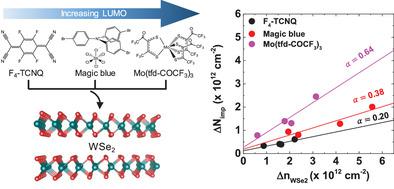当前位置:
X-MOL 学术
›
Adv. Mater.
›
论文详情
Our official English website, www.x-mol.net, welcomes your feedback! (Note: you will need to create a separate account there.)
Molecular Dopant-Dependent Charge Transport in Surface-Charge-Transfer-Doped Tungsten Diselenide Field Effect Transistors
Advanced Materials ( IF 29.4 ) Pub Date : 2021-09-17 , DOI: 10.1002/adma.202101598 Jae-Keun Kim 1, 2 , Kyungjune Cho 2, 3 , Juntae Jang 1 , Kyeong-Yoon Baek 1 , Jehyun Kim 1 , Junseok Seo 1 , Minwoo Song 1 , Jiwon Shin 1 , Jaeyoung Kim 1 , Stuart S P Parkin 2 , Jung-Hoon Lee 4 , Keehoon Kang 5 , Takhee Lee 1
Advanced Materials ( IF 29.4 ) Pub Date : 2021-09-17 , DOI: 10.1002/adma.202101598 Jae-Keun Kim 1, 2 , Kyungjune Cho 2, 3 , Juntae Jang 1 , Kyeong-Yoon Baek 1 , Jehyun Kim 1 , Junseok Seo 1 , Minwoo Song 1 , Jiwon Shin 1 , Jaeyoung Kim 1 , Stuart S P Parkin 2 , Jung-Hoon Lee 4 , Keehoon Kang 5 , Takhee Lee 1
Affiliation

|
The controllability of carrier density and major carrier type of transition metal dichalcogenides(TMDCs) is critical for electronic and optoelectronic device applications. To utilize doping in TMDC devices, it is important to understand the role of dopants in charge transport properties of TMDCs. Here, the effects of molecular doping on the charge transport properties of tungsten diselenide (WSe2) are investigated using three p-type molecular dopants, 2,3,5,6-tetrafluoro-7,7,8,8-tetracyanoquinodimethane (F4-TCNQ), tris(4-bromophenyl)ammoniumyl hexachloroantimonate (magic blue), and molybdenum tris(1,2-bis(trifluoromethyl)ethane-1,2-dithiolene) (Mo(tfd-COCF3)3). The temperature-dependent transport measurements show that the dopant counterions on WSe2 surface can induce Coulomb scattering in WSe2 channel and the degree of scattering is significantly dependent on the dopant. Furthermore, the quantitative analysis revealed that the amount of charge transfer between WSe2 and dopants is related to not only doping density, but also the contribution of each dopant ion toward Coulomb scattering. The first-principles density functional theory calculations show that the amount of charge transfer is mainly determined by intrinsic properties of the dopant molecules such as relative frontier orbital positions and their spin configurations. The authors’ systematic investigation of the charge transport of doped TMDCs will be directly relevant for pursuing molecular routes for efficient and controllable doping in TMDC nanoelectronic devices.
中文翻译:

表面电荷转移掺杂二硒化钨场效应晶体管中的分子掺杂剂相关电荷传输
载流子密度的可控性和过渡金属二硫属化物(TMDC)的主要载流子类型对于电子和光电器件应用至关重要。为了在 TMDC 器件中利用掺杂,了解掺杂剂在 TMDC 电荷传输特性中的作用非常重要。在此,二硒化钨(WSE的电荷传输性分子掺杂的效果2)使用三个p型分子掺杂剂,2,3,5,6-四氟7,7,8,8-四氰基(F调查4 -TCNQ)、三(4-溴苯基)铵基六氯锑酸盐(幻蓝)和钼三(1,2-双(三氟甲基)乙烷-1,2-二硫烯)(Mo(tfd-COCF 3 ) 3)。温度相关的传输测量表明,WSe 2表面上的掺杂剂反离子可以在 WSe 2通道中引起库仑散射,并且散射程度显着取决于掺杂剂。此外,定量分析表明,WSe 2之间的电荷转移量和掺杂剂不仅与掺杂密度有关,而且与每个掺杂剂离子对库仑散射的贡献有关。第一性原理密度泛函理论计算表明,电荷转移量主要由掺杂分子的本征性质决定,例如相对前沿轨道位置及其自旋构型。作者对掺杂 TMDC 的电荷传输的系统研究将与在 TMDC 纳米电子器件中寻求有效和可控掺杂的分子途径直接相关。
更新日期:2021-11-01
中文翻译:

表面电荷转移掺杂二硒化钨场效应晶体管中的分子掺杂剂相关电荷传输
载流子密度的可控性和过渡金属二硫属化物(TMDC)的主要载流子类型对于电子和光电器件应用至关重要。为了在 TMDC 器件中利用掺杂,了解掺杂剂在 TMDC 电荷传输特性中的作用非常重要。在此,二硒化钨(WSE的电荷传输性分子掺杂的效果2)使用三个p型分子掺杂剂,2,3,5,6-四氟7,7,8,8-四氰基(F调查4 -TCNQ)、三(4-溴苯基)铵基六氯锑酸盐(幻蓝)和钼三(1,2-双(三氟甲基)乙烷-1,2-二硫烯)(Mo(tfd-COCF 3 ) 3)。温度相关的传输测量表明,WSe 2表面上的掺杂剂反离子可以在 WSe 2通道中引起库仑散射,并且散射程度显着取决于掺杂剂。此外,定量分析表明,WSe 2之间的电荷转移量和掺杂剂不仅与掺杂密度有关,而且与每个掺杂剂离子对库仑散射的贡献有关。第一性原理密度泛函理论计算表明,电荷转移量主要由掺杂分子的本征性质决定,例如相对前沿轨道位置及其自旋构型。作者对掺杂 TMDC 的电荷传输的系统研究将与在 TMDC 纳米电子器件中寻求有效和可控掺杂的分子途径直接相关。



























 京公网安备 11010802027423号
京公网安备 11010802027423号